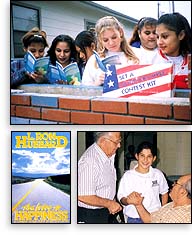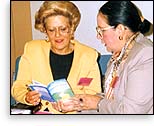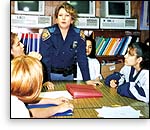
|


|
In the aftermath of each act of senseless youth violence, parents, teachers and civic leaders amplify the national discussion about the need to educate our nation’s children in values and morals.
One program has been successfully doing so for almost two decades, with results.
|
by Marc Steven

small revolution is occurring in part of the San Antonio, Texas school system, spearheaded by the Harlendale Alternative Center for at-risk kids. Three hundred and fifty 6th – 12th grade students sent to the Center as the result of disciplinary hearings have been undergoing radical shifts in their outlook in just six to nine weeks.
Naida Segura, counselor at the center, explains why. “I introduced The Way to Happiness to the Center after I saw it mentioned in a professional journal,” she says. “I was impressed with the way it provided the specific information the kids needed to turn around their lives.”
The The Way to Happiness which Segura refers to is a pocket-sized booklet containing 21 precepts comprising all of the basic, time-honored and common sense morals of a sound society. Each precept is explained with brief text.
“Although these children come from very difficult situations, once they have been exposed to The Way to Happiness, they are able to make good choices,” says Segura. “It is written in a style that is very simple and clear. It gives the children enough understanding to overcome peer pressure and environment or familial situations that would have them otherwise make the wrong decisions.”
Segura takes the students through each precept of the booklet in depth, and observes that the children realize aspects of their lives that they can change. The children then visit elementary schools in the area, under a program called the Student Experience Exchange (SEE), using The Way to Happiness to set a good example — one of the precepts in the booklet.
“Students in the SEE program tell younger students, ‘I want to make sure you don’t make the same bad choices that I made, and I’m going to tell you why,’” says Segura. The students have already worked out why in reading and applying principles from The Way to Happiness.
“It is truly amazing. My students have the undivided attention of the younger ones,” Segura states. “The program has given my kids self-esteem and confidence, a sense of value.”
The Center started the The Way to Happiness program with 5th-grade students, but according to Segura, the demand from the teachers was so great that they extended the program to all elementary grades.
Students contribute to a variety of other community projects, such as collecting food and clothing for the disadvantaged, and visiting the elderly. Segura finds that the kids will volunteer if they know what good will result.
The Way to Happiness has also been included in the activities of a family counseling group within the district, in which the hearing officer mandates a precept from The Way to Happiness as the focus for a specific community service project. An example of such a precept, according to Segura, is the one to “be competent.”
“Each precept is so fundamental that it encompasses many areas of life. I can see it blossom,” Segura says. “The booklet has generated a lot of interest. The program for teaching morals that was in place before just was not working.”
Making the Right Decisions
Over the past few decades, the teaching of morals in schools has been on a rapid decline, replaced by more “modern” psychological and psychiatric-based teachings which stress that kids figure out their morals and values on their own. (See also “Disorienting a Generation,”.)
The teaching of morals in schools has been frowned upon by some educators because of religious implications — since morals have traditionally been linked to religion — even if the morals being taught in schools are not religious in content.
With the The Way to Happiness, Segura says, the students are “making choices and decisions about values. Knowing how to do so is basically a human right, not a religious issue.”
After four years of implementing The Way to Happiness program, the Harlendale Alternative Center was awarded first place for the 1998/1999 school year in the national Set a Good Example contest which uses the booklet.
“Every now and then I meet or find out about one of our graduates from the program. I just came out of the hospital, for instance,” recounts Segura, “where I bumped into a graduate. He had returned to school and completed his studies, and then found a job at the hospital.”
The Way to Happiness Set a Good Example Contest is conducted by the Concerned Businessmen’s Association of America (CBAA), a national organization which encourages private sector business owners and individuals to take action if they are unhappy about the $200 billion that declining moral values amoung our youth is costing the economy each year.
Based on countless results in elementary, middle and high schools, and in special education settings like that of the Harlendale Alternative Center, the CBAA’s lifeblood for the two decades of its existence has been the single program to implement The Way to Happiness booklet in different settings in society.
After 15 years of running the Set a Good Example school contest, more than 12 million students in America have been reached with The Way to Happiness in nearly 11,000 schools.
The program has received hundreds of awards and recognitions from mayors, governors, congressmen and senators. In a 1994 study conducted in schools using The Way to Happiness materials, 85% of the teachers noticed positive changes in their pupils and 88% of the students felt they had gained from the booklet; 97% of the teachers wanted to continue with the program and 77% of the students said they used the precepts in their everyday lives.
With almost 51 million grade-school children and 108,520 schools in America, there is still some way to go, but consider the effect on society of the millions of students who are graduating with a solid grounding in morals.
An Amite, Louisiana high school principal gave an idea of that power when she said, “We are still reaping the rewards of having been involved in the Set a Good Example program. The seventh graders who began the program at our school are now graduating seniors who have distinguished themselves in all areas, including academics, athletics, drama, music and leadership roles. They have established goals and have a well-developed work ethic. They truly represent the ideals ... of the Set a Good Example project.”
The moral seems to be that if one treats children with dignity, recognizes their goodness, and shows them what to do, one receives good in return. If children don’t know the rules of the game, are coerced with drugs, coddled with confusing counseling and left with the idea that they should decide for themselves what is right or wrong, then confusion, at best, results.
One 8th grade student on the The Way to Happiness program put it this way: “If adults set a good example for us, then we learn to set a good example for younger kids. Who else do we have to look up to for help in our lives? If young people are going to do great things, then they need great examples.”
An Idea Whose Time Has Come
It may seem remarkable to some that a small booklet with a common sense moral code could create such positive effects. The power of an idea whose time has come cannot be disputed. The desire for an effective moral education is on the minds of teachers, parents and politicians throughout the country. A poll of parents showed that 79% were in favor of public schools teaching morals, which they rated second in importance only to writing and speaking skills.
With 53 million copies distributed in 57 countries and in 22 languages since it was first released 18 years ago by author and humanitarian L. Ron Hubbard, this little booklet is proving to be an easy and effective answer to the enormously complex problems that result when a society parts company with its moral code.
The Way to Happiness Foundation, which oversees the distribution of the booklet around the world, also runs programs in U.S. schools. More than 2,000 schools have participated to date. One such program is the annual Creating a Better World essay contest, asking children to write about how they feel particular precepts should be implemented to improve society. Not surprisingly, children have had much to say about where our society is going.
 One 13-year-old girl showed The Way to Happiness to her friends, who had been drinking, stealing, taking drugs, being promiscuous, and had dropped out of school and been in trouble with the police several times. They realized how much harm they were doing and weaned themselves off the drugs, stopped drinking and eventually quit everything else they were doing that was illegal and immoral. “The precept ‘Do Not Do Anything Illegal’ saved my friends’ lives, and mine. Now we read and use all the precepts every day. We are spreading The Way to Happiness to everyone, and one by one, creating a better world,” the student wrote.
A 15-year-old boy with a remarkable flair for writing stated, “There is a place where violence is commonplace and expected much as unpleasant weather. Where nothing is thought of armed robbery. Where narcotics and hallucinogens are sold like newspapers. Where the only safe haven can be found in alliance with a group of armed and hardened people who are forever defending and conspiring against other affiliations. Where brutal crimes are punished by temporary confinement measured in hours, or black marks on one’s record, or not at all. This fence-and-metal-detector-encircled institution is the high school. In this environment, the individual student is liable to fall back to very primitive philosophies to survive, in place of the morals that were never taught. The government’s solution is to build vandal-proof drinking fountains. We must bring students the morals in The Way to Happiness. We must bring them today. For without them, the future is dark.”
One 13-year-old girl showed The Way to Happiness to her friends, who had been drinking, stealing, taking drugs, being promiscuous, and had dropped out of school and been in trouble with the police several times. They realized how much harm they were doing and weaned themselves off the drugs, stopped drinking and eventually quit everything else they were doing that was illegal and immoral. “The precept ‘Do Not Do Anything Illegal’ saved my friends’ lives, and mine. Now we read and use all the precepts every day. We are spreading The Way to Happiness to everyone, and one by one, creating a better world,” the student wrote.
A 15-year-old boy with a remarkable flair for writing stated, “There is a place where violence is commonplace and expected much as unpleasant weather. Where nothing is thought of armed robbery. Where narcotics and hallucinogens are sold like newspapers. Where the only safe haven can be found in alliance with a group of armed and hardened people who are forever defending and conspiring against other affiliations. Where brutal crimes are punished by temporary confinement measured in hours, or black marks on one’s record, or not at all. This fence-and-metal-detector-encircled institution is the high school. In this environment, the individual student is liable to fall back to very primitive philosophies to survive, in place of the morals that were never taught. The government’s solution is to build vandal-proof drinking fountains. We must bring students the morals in The Way to Happiness. We must bring them today. For without them, the future is dark.”
Another Chance
“The Way to Happiness” program has given my kids self-esteem and confidence, a sense of value.
– Naida Segura
Counselor
Harlendale Alternative Center
|
The CBAA and The Way to Happiness Foundation also direct additional projects using The Way to Happiness to address the subjects of drugs, crime, violence and gang life, most of which are run in coordination with family service agencies, police departments and delinquency prevention groups.
While it is best to start moral education early on in life, it is not too late for the 1.8 million Americans in jail — a figure expected to rise to 3.5 million over the next five years — who went through school without the benefit of a workable Morals 101.
The Way to Happiness booklet has also been finding its way into prisons and judges’ chambers. Where 80 percent of released offenders are behind bars again within a year, between 80 and 98.5 percent of those who have completed a The Way to Happiness program designed for inmates stay honest and straight after release. The prison program using The Way to Happiness is run by Criminon, an international criminal rehabilitation group. Currently, 2,250 prisons in the U.S. are participating in the program.
As contained in Precept Four of The Way to Happiness, “Bringing a child into the world today is a little bit like dropping one into a tiger’s cage.” But, as the author also later stated, “If people... could give each other a way to happiness, yes, the world would change. Think what would occur if people became decent to one another again!”
With a simple booklet like The Way to Happiness, and programs to implement it such as the Concerned Businessman’s Association of America’s “Set A Good Example” Contest and The Way to Happiness Foundation’s “Creating a Better World” Essay Contest, the distinct possibility exists that educators and parents can rapidly alter the direction schools and society have taken over the last few decades, and create the kind of world we would all rather live in.
For further information on The Children’s Set a Good Example Campaign and School Contest, contact Concerned Businessmen’s Association of America (CBAA) at 13428 Maxella Avenue No. 248, Marina del Rey, California 90292. Website address: www.cbaa.org, e-mail: cbaa@primenet.com.
|

|














